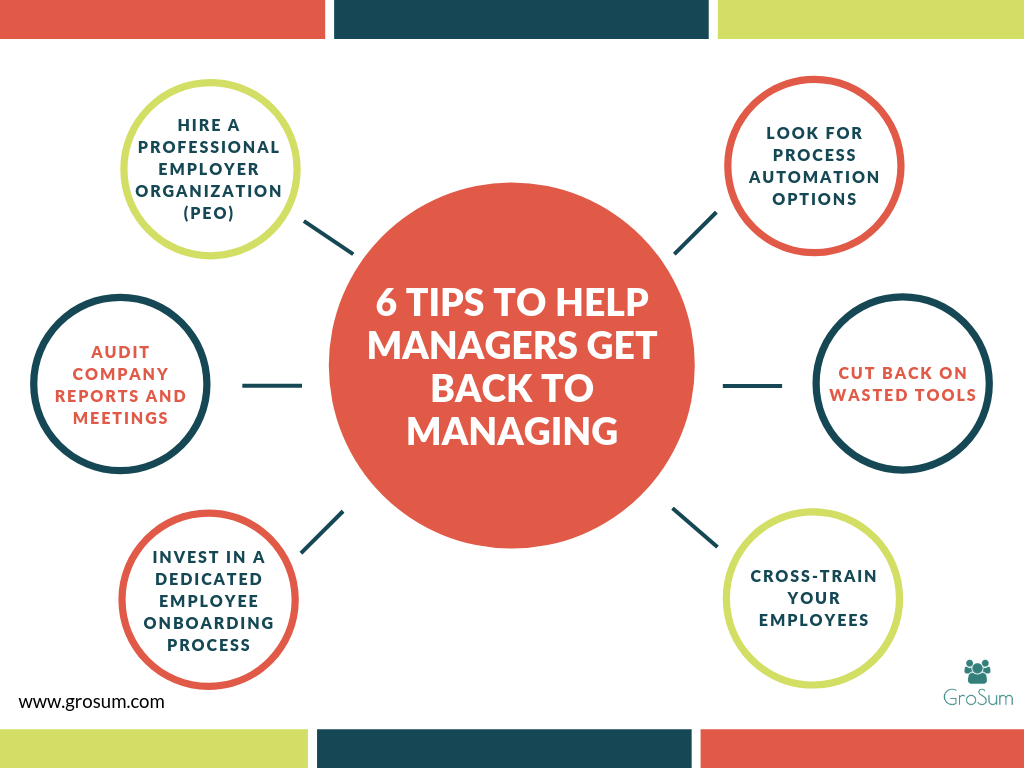
You may be a manager, but do you even have time to manage? Instead of guiding your employees through projects and training them to be their best, do you sit behind a desk all day rummaging through papers and working through an endless task list?
Managers often say that they get caught in the minutia of projects, executing tasks that should be delegated. This is a pitfall for many managers, and it often leaves their employees to make important decisions with little direction or strategic insight from their superiors.
Fortunately, with a little organizational restructuring, you can cut back on your daily tasks and create time for your employees. Here are six tips to help managers get back to managing.

Hire a Professional Employer Organization (PEO)
If your daily human resource, payroll, and tax processes are overwhelming to the point where you can’t handle them, consider hiring a professional employer organization (PEO) to take over this part of your work.
A PEO in the HR context has more power than a payroll company and really digs into the operations and financial processes of your business. They handle areas like tax remittance, government filings, and employee benefits for you, taking that part of the HR work off your plate.
Hiring a PEO is often more affordable than taking on a full-time employee (or multiple) to handle your organizational needs. Plus, hiring employees comes with additional onboarding and management expenses. Instead, you can outsource your HR responsibilities to a trusted and experienced provider who will provide cost-savings and assurance.
Look for Process Automation Options
Time is money. The more time you spend working on something, the more you are pulling away from other important tasks. Look at your day-to-day processes and identify tools you can use to automate your work.
For example, 25% of employees still track their time on spreadsheets, which means managers likely spend hours reviewing and adjusting those documents. Switching to a software system or automated tracking process can save time for both parties, without driving up the costs of the company.
You would be surprised what types of processes are automated in this day and age, you might be able to shave several hours off of your week just through process improvement.
Audit Company Reports and Meetings
Meetings can be productivity killers in the workplace – and they can hurt your bottom line. More than $37 billion is lost every year in unnecessary meetings. Employees spend more than five hours per week in meetings and four hours preparing for them. This is exacerbated once you reach the management level. Then you are likely to spend more than 12 hours in meetings each week.
Look at your meetings to see what is really necessary. If you can cut back on a few meetings per week, or even turn hour-long meetings into 20-minute check-ins, then you can start to free up your schedule and the schedule of your employees.
Along with auditing your meetings, look at your daily, weekly, and monthly reports that you compile. What sections of the reports can be removed? What reports are created but used by no one? See if you can stop making and reviewing these reports to save more time.
Cut Back on Wasted Tools
Along with auditing your reports, look for various tools or subscriptions that might have been valuable at one point but are taking up space now. Maybe at one point you wanted to run A/B tests on your website but haven’t had the time. If you still pay for the A/B testing software, it may be time to cancel.
Eliminating one software tool might not make a significant impact; however, if you find four or five services that you don’t use then these savings add up.
Look at your tools and try to quantify how they help your business. Track the exact number of hours saved per week or the amount of incremental value earned each year. You want your tools to work for you, not weigh you down.
Invest in a Dedicated Employee Onboarding Process
Every company has a learning curve with onboarding employees. It can take anywhere from three months to an entire year for employees to learn all of the processes involved with working at an organization. During this time, companies are less profitable because their new employees aren’t performing at 100% and because management needs to spend more time training them.
One of the best things you can do for your organization is to develop an onboarding and training process with clear goals and tasks. Organizations with dedicated onboarding processes have a 62% greater new hire productivity and 50% greater new hire retention. This means that your new employees understand the work faster and are less likely to leave, forcing you to start the hiring process all over again.
Cross-Train Your Employees
Absenteeism is a major issue in many companies. According to Forbes, “unscheduled absenteeism costs roughly $3,600 per year for each hourly worker and $2,650 each year for salaried employees.” These costs come from the wages paid to absent employees and the costs of picking up their part of the work. One way companies can reduce the effects of absenteeism is with cross-training.
We have talked about the benefits of cross-training before, but they bear repeating. When other employees can step in and do the work of their missing counterparts, the work still gets done with minimal interruptions. Plus, you as a manager don’t have to worry about assigning tasks to others or picking up the slack. Your staff will figure it out themselves. This reduces your mental burdens while saving the company money and time.
Take Away
Your time as a manager and leader is valuable. You know more than most of the employees and were promoted to make a more strategic role in the organization. Instead of getting swamped by complicated tasks and endless HR duties, reorganize your processes so you can focus on guiding your company into the future. Of course, it helps to have the right employees in the first place, and conducting thorough pre-employment screening beforehand can help ensure that you do.
About the author
Christine Soeun Choi is a digital marketing associate at Fit Small Business. Currently based in NYC, she has a background in business studies and math with a passion for business development. Outside of work, Christine enjoys taking photos, exploring artwork, and traveling.